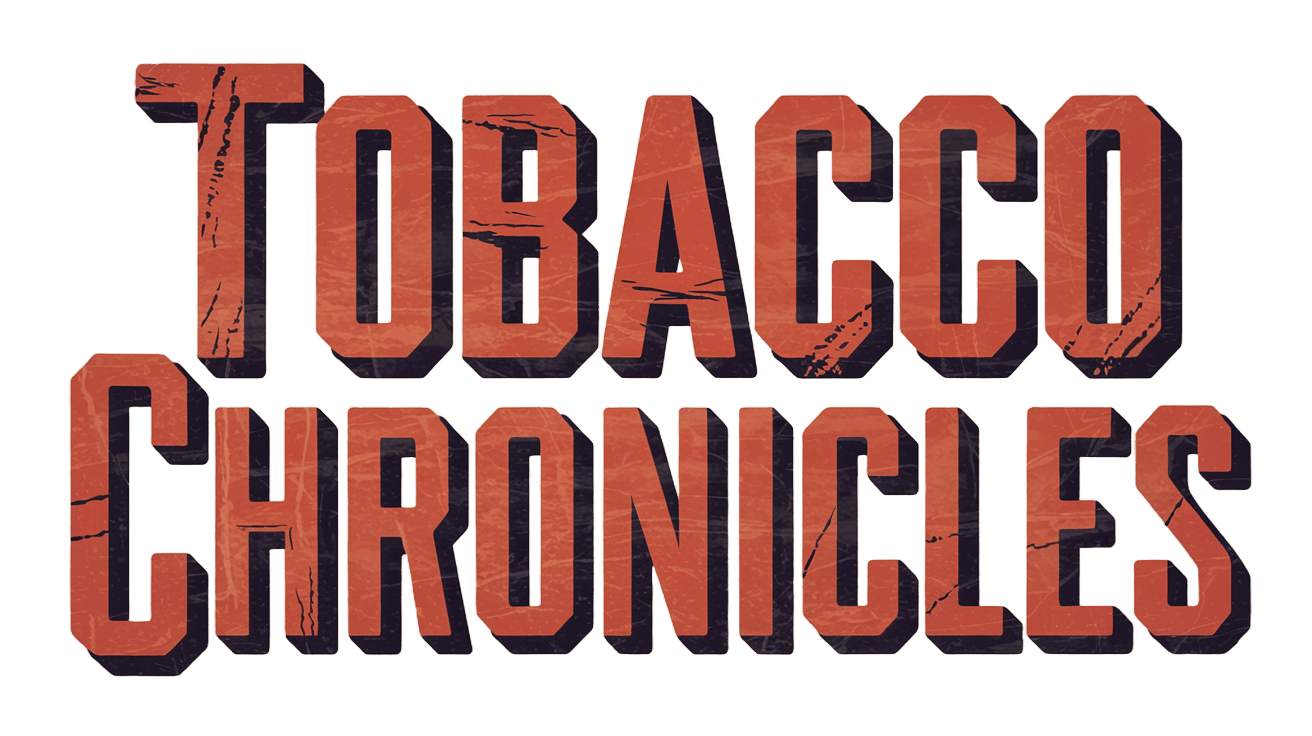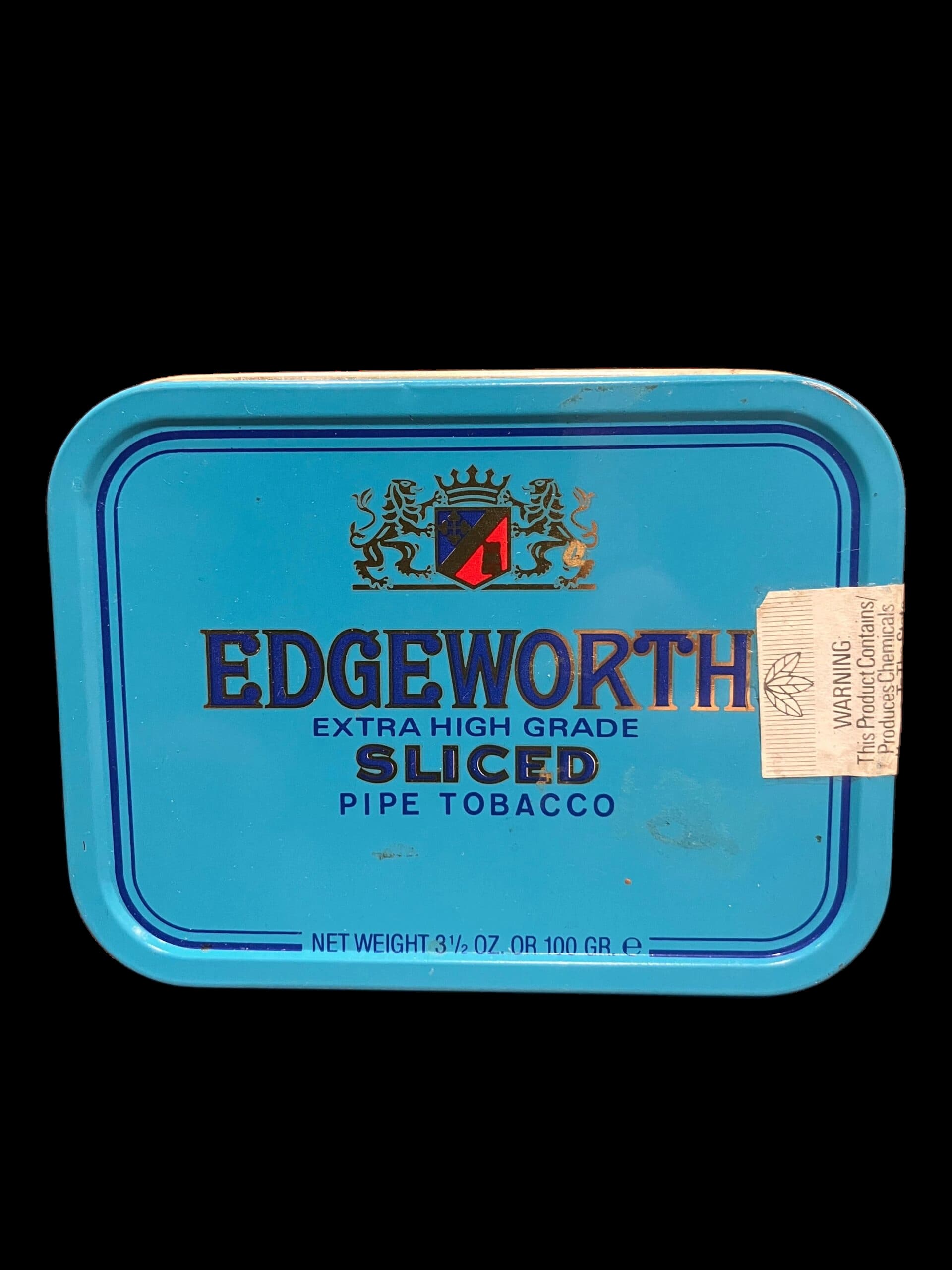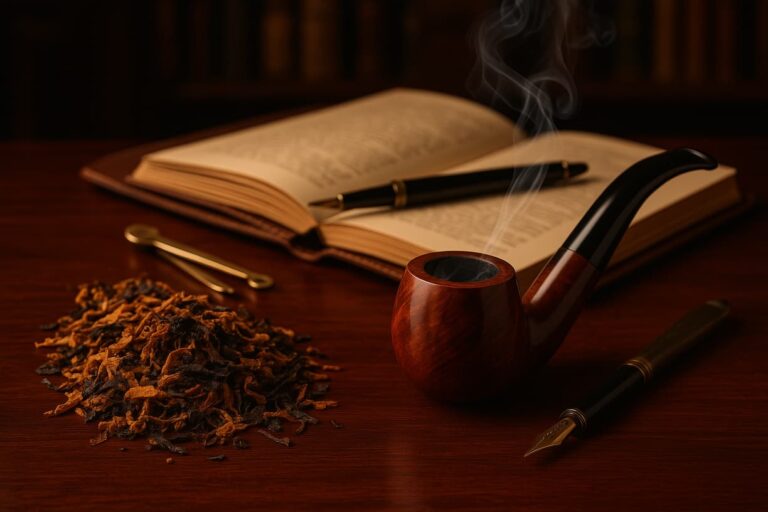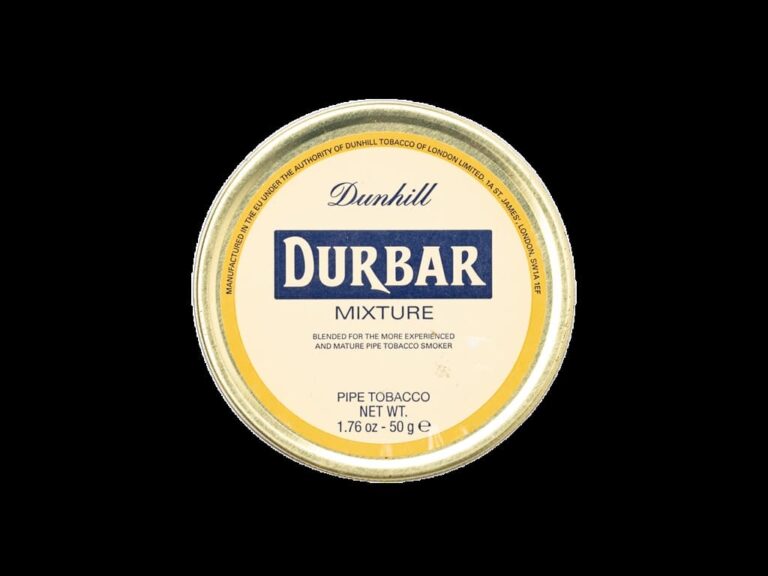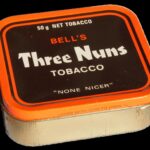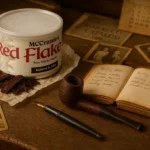“In 1903, when the Wright brothers were learning to fly and Henry Ford was perfecting the assembly line, two brothers in Richmond, Virginia were quietly revolutionizing how America smoked tobacco. They probably had no idea they were making history.”
The Revolutionary Moment
Picture this: It’s 1903, and you walk into a tobacco shop. The air is thick with the aroma of loose tobacco stored in large wooden barrels and glass jars. You ask for your usual pipe tobacco, and the shopkeeper scoops it into a paper bag, weighing it on a scale. The tobacco might be fresh, it might be stale, it might be contaminated with dust or moisture—you never really knew what you were getting.
Then someone hands you a small, rectangular tin with elegant blue lettering: “Edgeworth Extra High Grade Sliced.” You’ve never seen anything like it. Tobacco in a sealed container? The idea seems almost absurd. But you try it anyway, and everything changes.
This wasn’t just a new tobacco—it was a new way of thinking about tobacco. Charles and Herbert Larus had just invented the modern pipe tobacco industry, though they probably didn’t realize it at the time.
Why I Had to Find It
I’ve been chasing Edgeworth Sliced for fifteen years. Not just any Edgeworth—the real thing, the original, the tobacco that started it all. I’d heard the stories, read the reviews, seen the empty tins on eBay selling for ridiculous prices. But I’d never smoked it.
The hunt became an obsession. I scoured estate sales, haunted tobacco shops, pestered old-timers at pipe shows. “Do you have any Edgeworth Sliced?” became my standard greeting. The answer was always the same: “Wish I did, son. Wish I did.”
Then, last year, lightning struck. An elderly gentleman in North Carolina was selling his late father’s tobacco collection. Buried in a box of mostly common blends was a single, unopened tin of Edgeworth Sliced from 2003—one of the final production years. The price was steep, but some things are worth any cost.
The Tin Itself: A Piece of History
Before I even opened it, I spent an hour just examining the tin. This wasn’t just packaging—it was a piece of American industrial design history. The blue color, the elegant typography, the confident proclamation of “Extra High Grade”—everything about it spoke of quality and pride.
The tax stamp was still intact, a little paper time machine that transported me back to an era when tobacco was regulated differently, when pipe smoking was commonplace, when quality mattered more than quarterly profits. I almost felt guilty breaking that seal, like I was destroying something that belonged in a museum.
But tobacco is meant to be smoked, not preserved. History is meant to be experienced, not just observed. So I took a deep breath and opened the tin.
First Impressions: The Aroma of America
The tin note hit me like a wave of nostalgia for a time I’d never lived through. This was pure American tobacco—no pretense, no artifice, just honest Burley leaf processed with skill and care. The aroma was rich and nutty, with hints of molasses and earth that spoke of Kentucky farms and Tennessee curing barns.
But there was something else, something I hadn’t expected. Age. This twenty-year-old tobacco had developed a complexity that fresh Burley simply can’t possess. The sharp edges had been smoothed away, the flavors had married and mellowed, creating something that was both familiar and entirely new.
The tobacco itself looked different from modern blends. The slices were thicker, more substantial, with a darker color that suggested careful aging and processing. This wasn’t mass-produced commodity tobacco—this was craftsmanship you could see and smell.
The Smoke: Meeting a Legend
I chose my Kaywoodie Drinkless for this historic smoke—an American pipe for an American tobacco. The irony wasn’t lost on me: both the pipe and the tobacco represented a golden age of American manufacturing that seems impossibly distant now.
The first few puffs were a revelation. This wasn’t just good Burley—this was Burley perfected. The nutty character that defines the leaf was there in abundance, but refined, polished, elevated to an art form. There was no harshness, no bite, just smooth, satisfying flavor that filled the mouth and lingered on the palate.
As the bowl progressed, the tobacco revealed layers of complexity I hadn’t expected. The molasses notes became more pronounced, adding a gentle sweetness that complemented rather than masked the natural tobacco flavors. There were hints of cocoa, suggestions of coffee, whispers of spices I couldn’t quite identify.
But what struck me most was the tobacco’s honesty. This wasn’t trying to be anything other than what it was—premium American Burley, processed with skill and aged to perfection. In an era of exotic blends and complex mixtures, Edgeworth Slices was refreshingly straightforward: great tobacco, expertly prepared, nothing more, nothing less.
The Burn: Engineering Excellence
One thing that immediately set Edgeworth apart was how perfectly it burned. The slicing process that gave the tobacco its name wasn’t just for show—it was functional engineering. The uniform thickness of the slices ensured even burning, while the careful moisture content prevented hot spots and harsh flavors.
I smoked that first bowl down to ash without a single relight. The tobacco burned cool and even from first light to final puff, maintaining its flavor profile throughout. This was tobacco designed by people who understood the mechanics of pipe smoking, who had thought through every aspect of the experience.
The room note was equally impressive—rich and pleasant without being overwhelming. This was tobacco you could smoke around others without apology, the kind of blend that made people ask what you were smoking rather than asking you to take it outside.
Understanding the Legacy
As I smoked that precious tin over the following weeks, I began to understand why Edgeworth Slices had achieved legendary status. This wasn’t just about the tobacco itself—though that was exceptional—it was about what it represented.
Edgeworth Slices was proof that American tobacco could compete with anything the world had to offer. At a time when European blends dominated the premium market, the Larus brothers had created something uniquely American that didn’t apologize for its origins or try to imitate foreign styles.
The tobacco was also a testament to the power of innovation. The tin packaging, the slicing process, the national advertising—all of these were revolutionary concepts that changed how tobacco was sold and consumed. Edgeworth wasn’t just a product; it was a new way of doing business.
The Sadness of Endings
Smoking that final bowl of Edgeworth Slices was bittersweet. I was experiencing something that could never be replicated, never be replaced. When that tin was empty, my connection to this piece of tobacco history would be severed forever.
The discontinuation of Edgeworth Slices in 2004 marked the end of more than just a tobacco brand—it marked the end of an era. The knowledge and expertise that went into creating this blend died with it. Modern attempts to recreate Edgeworth have fallen short, lacking the soul and character that made the original special.
But perhaps that’s as it should be. Some things are meant to be finite, meant to be treasured precisely because they can’t last forever. Edgeworth Slices belongs to history now, a reminder of what American tobacco craftsmanship could achieve when quality mattered more than profit margins.
What We Lost
Smoking authentic Edgeworth Slices made me realize how much we’ve lost in the modern tobacco world. This wasn’t just about one blend—it was about an entire approach to tobacco making that valued tradition, craftsmanship, and patience over efficiency and cost-cutting.
The Larus brothers understood that great tobacco couldn’t be rushed. They invested in quality leaf, took time with processing, and refused to compromise on standards. The result was a product that remained essentially unchanged for over a century—a testament to getting it right the first time.
Modern tobacco companies could learn from this example, but they probably won’t. The economics of the industry have changed too much, the market has become too fragmented, the knowledge has been lost. We live in an age of quarterly profits and focus groups, not century-long commitments to excellence.
The Verdict: A Perfect Ten
If I had to rate Edgeworth Slices, I’d give it a perfect score—not just for the tobacco itself, though that was exceptional, but for what it represented. This was American tobacco at its absolute peak, a product that changed an entire industry and set standards that have never been equaled.
For those lucky enough to find a tin of authentic Edgeworth Slices, treasure it. Smoke it slowly, mindfully, with the reverence it deserves. You’re not just smoking tobacco—you’re experiencing history, connecting with a tradition that spans generations, participating in a ritual that links you to every pipe smoker who ever appreciated true quality.
And for those who never get the chance to try the original, don’t despair. The spirit of Edgeworth lives on in every pipe smoker who values quality over convenience, tradition over trends, craftsmanship over mass production. In a world that seems increasingly disposable, that’s a legacy worth preserving.
Rating: ★★★★★ (5/5 stars)
Availability: Discontinued (2004)
Strength: Medium to Full
Flavor Profile: Nutty, molasses, earth, cocoa
Recommended For: Experienced smokers, history enthusiasts, Burley lovers
Edgeworth Slices taught me that the best tobaccos are more than just products—they’re pieces of history, connections to the past, reminders of what’s possible when people care more about quality than quantity. In a world of endless choices and constant change, that’s a lesson worth remembering.
